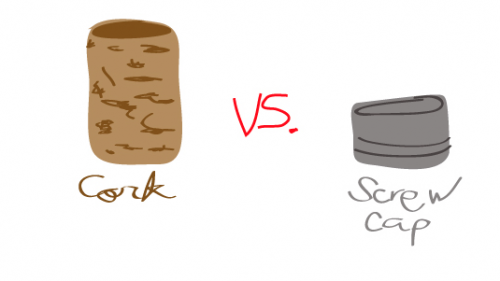 I’m sure many of you have wondered, as I have, why some wines have corks and some have twist tops or other means of closures. It’s an interesting question that our wine guru Terry Rogers is here to explain.
I’m sure many of you have wondered, as I have, why some wines have corks and some have twist tops or other means of closures. It’s an interesting question that our wine guru Terry Rogers is here to explain.
The history of cork as a stopper was recorded to date back to the Egyptians thousands of years ago. Ancient Greeks also used cork oak bark to make fishing buoys, sandals and stoppers for vessels for wine and olive oil. The Romans found many uses for cork including the construction of house roofs and beehives, ship construction and women’s shoes. The world’s first cork stopper factory opened around 1750 in Spain, marking the beginning of the industrial application of cork. Cork stoppers officially arrived in Portugal around 1700.

Over centuries, the number of wineries that have in the past or are still using cork number in the hundreds of thousands. That may be but consider the fact that it takes 25 years for a cork tree to truly come to fruition to produce really good cork. The majority of the cork trees are in Portugal.
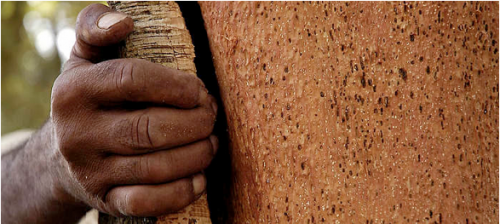 What exactly is cork? The precious and versatile vegetable tissue known as cork is the outer bark of the cork oak tree, not the trunk, as many people might think. Cork is most easily stripped off the tree in late spring and early summer when the cells are turgid and fragile and tear without being damaged. The tree then quickly forms new layers of cork and restores its protective barrier. No tree is cut down. This simple fact makes cork harvesting exceptionally sustainable, leading to a unique balance between people and nature. It’s a highly skilled business in the western Mediterranean, where each generation has tutored the next in a continuous process from the time of the ancient Greeks.
What exactly is cork? The precious and versatile vegetable tissue known as cork is the outer bark of the cork oak tree, not the trunk, as many people might think. Cork is most easily stripped off the tree in late spring and early summer when the cells are turgid and fragile and tear without being damaged. The tree then quickly forms new layers of cork and restores its protective barrier. No tree is cut down. This simple fact makes cork harvesting exceptionally sustainable, leading to a unique balance between people and nature. It’s a highly skilled business in the western Mediterranean, where each generation has tutored the next in a continuous process from the time of the ancient Greeks.
 The harvesting cycle is 9-12 years long, and it takes at least 25 years for a new tree to become profitable.
The harvesting cycle is 9-12 years long, and it takes at least 25 years for a new tree to become profitable.
- The first stripping produces cork that is too hard to be easily handled. It’s used in products like flooring and insulation.
- 9 to 12 years later a second harvest produces better material, but still not good enough for cork bottle-stoppers.
- Only the third and subsequent harvests produce cork with an even structure good enough to be used for wine closures.
The cork oak tree will then provide a harvest for some 200 years.
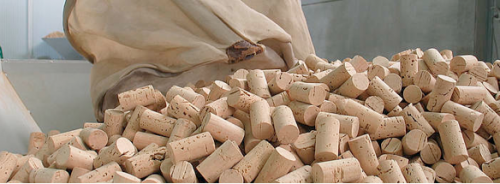
Cork’s natural properties make it eminently suitable for its principle use worldwide: as a bottle-stopper. It is very light, yet impermeable to liquids and gases, elastic and compressible, an excellent insulator, fireproof, and resistant to abrasion. Above all, it is completely natural, renewable, and recyclable. But the prolonged process has resulted in less availability, higher prices and sometimes a decrease in quality. And this decrease in quality can lead to the bane of the wine industry – TCA. TCA, otherwise known as cork taint, is a contamination caused by a chemical compound from airborne fungi that can infest the cork, causing an aroma in the bottle which is distinct and unpleasant, frequently described as resembling a moldy newspaper, wet dog or damp basement. This increasingly widespread cork contamination is why the wineries have had to look for other sources of closures for their products.
I am sure we will still never see Chateau Lafite Rothschild or Chateau Petrus going to a Stelvin (screwcap) closure but many others have. The other choice is a synthetic cork. These are made from a plastic compound designed to look like a natural cork, but without the risk of TCA.
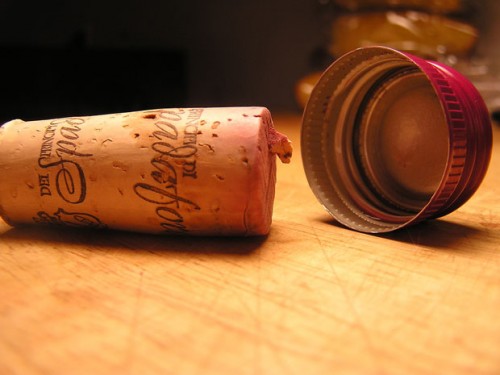 When I started in the wine industry in 1978 good wines only had corks. All the jug wines on the shelves had screw caps and so our perception of a wine that had a screw cap is that of one not as sophisticated as one with a cork. It was tough for me, even being in the business, to warm up to those synthetic corks. If you have a wine that has a synthetic cork and it is white, you will definitely want to chill it. Remove the cork and manually put it back in half way so you can pull it out easily before placing in the refrigerator. The minute you start refrigerating wines with synthetic corks they start to cling to the bottle and it is a real job to get them out.
When I started in the wine industry in 1978 good wines only had corks. All the jug wines on the shelves had screw caps and so our perception of a wine that had a screw cap is that of one not as sophisticated as one with a cork. It was tough for me, even being in the business, to warm up to those synthetic corks. If you have a wine that has a synthetic cork and it is white, you will definitely want to chill it. Remove the cork and manually put it back in half way so you can pull it out easily before placing in the refrigerator. The minute you start refrigerating wines with synthetic corks they start to cling to the bottle and it is a real job to get them out.
Some of the larger wineries such as Beringer, Franciscan, Estancia that produce over 300,000 cases per year per winery were discovering that one out of every 12 bottles was corked!! This was beginning to hurt their reputations as there was the possibility of consumers moving to other products and not being loyal.
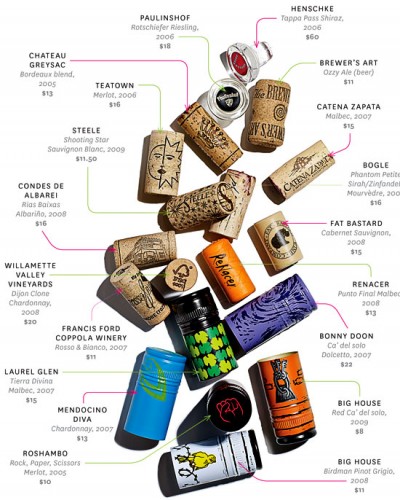
On that note, many of the suppliers moved to the synthetic cork. There is a machine/computer that can decipher whether the cork is tainted. When a winery buys cork they have to buy from a cork producer that has a tree farm. Some of these producers are on the up and up and but some are not. In general you get what you pay for. The wineries have a computer test one cork out of the bag the thousand of corks they receive. If the one cork is bad they automatically return whole bag.
You may not necessarily even know if you are drinking a corked wine for not all tainted wine carries the distinctive smell of TCA. What the cork can do is basically strip the wine of its fruit and you would not have a clue unless you know what that wine normally tastes like. I have had many wines like this. It is ever so slight; but there is no fruit/flavor in the wine and it is a true disappointment. And this is not only a problem for the consumer but for the winery as well because when a customer tastes a wine that has had the fruit stripped from it, they may never realize and just assume that this bland bottle is how the wine should taste. Obviously one would never purchase that label again.
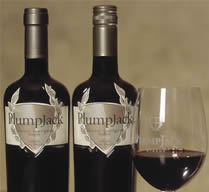 One of the first American high end wines in the over $100 category to go screw cap was Plumpjack reserve Cabernet – that shocked the wine world.
One of the first American high end wines in the over $100 category to go screw cap was Plumpjack reserve Cabernet – that shocked the wine world.
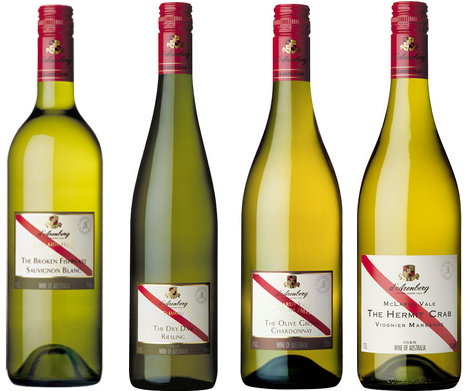 Most of the New Zealand and Australian wines that are fit for consumption within a two year period are definitely all going screw caps. For example, d’Arenberg, the wonderful winery we featured last week, have now almost completely switched to alternative closures, primarily screwcaps. As one of my suppliers put it “this is great I can get to the wine sooner”. In many instances if a wine does not have to be cellared for years and is meant to be drunk sooner rather than later; screw caps are the way to go.
Most of the New Zealand and Australian wines that are fit for consumption within a two year period are definitely all going screw caps. For example, d’Arenberg, the wonderful winery we featured last week, have now almost completely switched to alternative closures, primarily screwcaps. As one of my suppliers put it “this is great I can get to the wine sooner”. In many instances if a wine does not have to be cellared for years and is meant to be drunk sooner rather than later; screw caps are the way to go.


This is such an educational post! I hate the synthetic corks and can never get them back in the bottle to store it for a few more days. Screw caps are great and I’m getting used to them. I admit that I was shocked the first time I ever saw one!
Hi Stacy – thank you! Did you notice what Terry said about the synthetic corks on white wine – she suggests you take the cork out before chilling and then putting it back halfway. And yes, I’m getting used to the screw caps as well.
As usual a very interesting post! Thank you…
Thank you Heather – something I’d always wondered about!
Once again I learned a lot from your post and since I drink wine this was hugely interesting to me. Good job……
AO – So glad you enjoyed the post. Everything about wine interests me!!
Something about a cork says celebration more than a screw cap which reminds me of the wine coolers we drank in college! Great post and so interesting…
Buzz – Totally agree – still prefer a cork but clearly they are on the way out for many wineries! Barely remember what I drank in college!!
Wow, what an interesting post! Thanks a million for sharing!
Loving your blog :))
Hi Claudia – Thank you – and welcome. Hope to see you again soon!
I have always wondered about this…now I don’t have to think about that again.
Great post!! I will be showing off my knowledge this weekend thanks to you.
Hi Jane- Always good to learn something new – let me know if anyone is impressed with your new found knowledge!
Wow, what an educational and an enjoyable read. I did not know that most cork trees are found in Portugal, but not surprising since the vegetation in Portugal is so lush and even rather tropical in feel – like in Sintra.
Thanks Barbara – I didn’t know about Portugal either – but yes, you’re right about the lush vegetation!
GREAT post! Personally to me, I will always opt for a cork over a screw on. It just seems so much more elegant and refined then screwing off a top which seems akin to wine in a box…lol. I know many are doing it now but I love the cork, smelling it, (even though I have no idea why) and sometimes keeping them in a big bowl….just something about that cork that is a sign of being a full fledged sophisticated grown up able to drink a nice bottle of wine that I am not ready to give up to a screw top bottle!
TEH – I do think we all prefer cork but who knows for how long and too funny – I keep my corks in a big bowl in my pantry as well.
Call me old fashioned…but I do love the classic cork. I’m sure in a taste test though, I would never know the difference. Bottoms up!
PPT – The cork definitely has much more appeal and as Terry said, the big French wines probably won’t be switching to Stelvin any time soon! We might just have to pay a premium for cork!
Really enjoyed this post as a wine enthusiast. I got a bit of education about this subject at a local wine shop a couple years ago when I asked for a recommendation for a friend’s birthday and was handed a bottle with a screw on cap. My friend, not a huge wine drinker, looked at me skeptically when I told her that the shop owner said that many wineries are going to replace the cork. LOL!
I still love the traditional cork and the uncorking ritual.
We are all still in the cork generation. I do believe that at some point the screwcap will become easier to take! I understand about the gift giving. When a customer asks me for a gift for someone I have to always opt for cork finish since you never know if the person receiving the gift knows the wine and wonders what could have possibly be spent on a screw cap! I am certainly warming up to the screw cap closures.
Hi Karen – Glad you enjoyed! I know – the screwcap just doesn’t hold the same appeal but as you discovered, many good wines are now switching over!
Such a cool history on corks – who knew? Thanks for an informative and fun post.
Kate – I think it’s so interesting as well – who knew is right!
Hi Q,
I have had corked wine and it is really disappointing…nice if they can find a way to get past that and we can simply enjoy a great bottle of wine without the worry… informative post…
maureen
Hi Maureen – Yes, me too – and as Terry said, many wineries lose business from corked wine that doesn’t smell but just has no flavor!
Thanks for the information. I’ve definitely seen this trend occur and it’s had me break out the Rabbit corkscrew less often!
CCL – LOVE my Rabbit corkscrew – what a great invention. Can’t tell you how many corks I split in the old days!
Totally fascinated by the history and story of how they get the cork. Going to be relaying all this to my husband who loves this type of thing.
I also thought screw caps were a bit cheesy but now I feel differently, very informative (as usual). Will be looking at cork quite differently now.
Hi Jeanette – It was the same for me – I will not be looking at screw caps with the same disdain any longer!
I really enjoyed this educational post. Apart from being difficult to get out after chilled, do you think synthetic corks are alright?
Mary Ann
Mary Ann – From what I’ve read and Terry said, I do think the synthetics are ok but perhaps Terry will chime back in on this.
Synthetic corks are very difficult once the wine is chilled; so make sure you take the cork out and jus manually put it back in half way before you chill the wine. Try new zealand sauvignon blancs that are screw cap or the drouhin st. veran that is screwcap and delicious; we are into some really good french vintages where you can get great wines for not alot of money
That is such an interesting post..I always learn so much from your posts:) I usually go with cork as its more elegant and it just fits better..but its so interesting to read about the background of it all. Im going to send this post to my Balazs. He will truly enjoy reading it too:) Have a fantastic day, my dear
Hugs and kisses
Ps: I am hosting a natural cosmetics GIVEAWAY today! Hope you’ll join in :)
Hi Diana – Thank you! Yes, this is good post for the guys as well. And as you can see, Terry said in her comments here that she always suggests a bottle of wine with a cork as a gift – it still has a more upscale connotation.
And now I know. This is yet another example of how nothing is ever as simiple as one might imagine. I was convinced it must be less expensive to cap with a screw top rather than cork. I’m actually pleased to have been wrong. Case closed. Thanks for the lesson. Roxanne
Hi Roxanne – Exactly! Why I always love knowing the back story – usually some interesting additional information!!
Wow! We went to Sonoma a few months ago and never even gave a second thought to the corks. Very informative!
SC – I had wondered why so many bottles now have screw tops – but now I know!!
Living in CA my life revolves around wine and visiting Napa. This has been a topic of discussion amoung our wine friends and the wineries when we’re visiting. More and more wineries (high end) are moving in this direction. However, I love the detail you put into this post and the process behind the cork. Love your blog posts!
Hi Ann – Thank you!! And yes, I find this whole migration from cork fascinating. Hopefully some will stay with it – nothing is like hearing the pop!
This is a great post, and close to my heart. I love corks (and have quite a collection), but, I must say, I love those screw tops as well. They are SO unromantic and I was against them for so long, but they are easy and do a much better job preserving the vino!
Thanks for all of this information!!
SM – Thank you. Curious how you display your collection of corks. I still love a bottle with a cork but am certainly getting more accustomed to the screw tops.
Q — I just shared this with my SM friends on Facebook — come by and “like’ it!! I also shared you with my personal friends. Thanks again — great information!
SM – will stop by in a sec! Thanks!
LOVE the convienence of a screw cap – especially as when alone I tend to have just 1 glass, I think the wine keeps longer. My friends might poke fun of me but I seek out good wines at my grocery store with screw caps, I won’t buy corked wines any longer!
AD – Definitely one of the advantages of the screw cap! And now that more and more wineries are gravitating towards it, there will be many more choices!
Cork for sure…we need to keep the cork forests managed properly! So funny because I was going to do a post on this at some point.
Hi Danielle – yes, that is clearly a priority! Too funny – that has definitely happened to me before!
Cork for sure…we need to keep the cork forests managed properly!
Thank you for posting this informative background of cork. My husband and I make diposable cup sleeves (for hot or cold drinks), purses, wallets and more out of cork. I appreciate this posting on what cork is and why its useful!
http://www.coolcorc.com
Hi Jessica – how interesting! I will definitely have to check out your company!
Thank you Quintessence. Please let me know if you would like more
information. Thank you again for posting this information on cork!
Well, I just learned something interesting! How random…corks. This is the kind of info. my 14 year old son brings to me daily. Now I can “dish back”with him tomorrow!~ Hey son, “do you know the history of corks?” (I can see me now….) thanks!
Hi Sarah – It is interesting isn’t it – but not totally random – Wednesdays are wine days so the cork vs. screw tops relate to that. I’m glad I was able to give you some ammunition for your son!